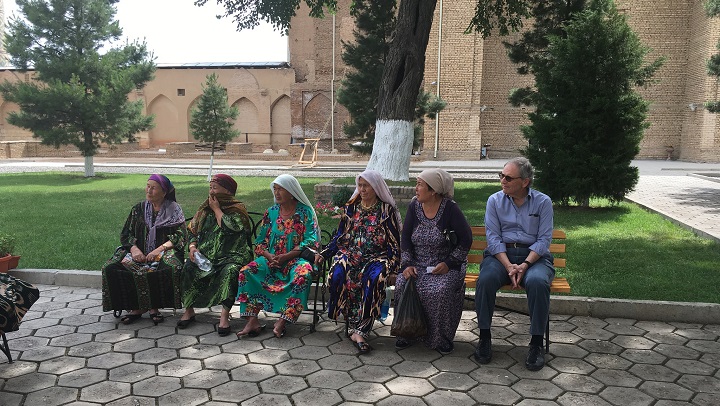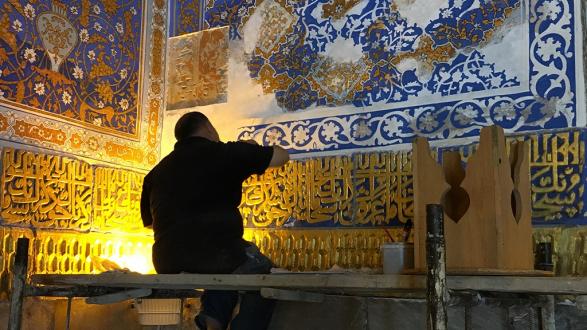In the wake of a visit by U.S. Secretary of State John Kerry, a Pacific Council delegation recently traveled to Central Asia to explore the region’s economy, unique culture, and political environment. Delegates visited Astana and Almaty in Kazakhstan, and Tashkent, Samarkand, and Bukhara in Uzbekistan. Briefings covered economic diversification efforts, corruption reform, education, and each country’s relationship to Russia and China.
Delegates met with U.S. Ambassador to Kazakhstan George Krol; Nazabayev University President Shigeo Katsu; Kazakhstan Foreign Minister Erian Idrissov; Kazakhstan Prime Minister Karim Massimov; business leaders from the Kazakhstan chapter of the Young Presidents Organization; leading dissident and chairman of the Kazakhstan International Bureau for Human Rights and Rule of Law Yevgeniy Zhovtis; Uzbekistan First Deputy Foreign Minister Javlon Vakhabov; U.S. Ambassador to Uzbekistan Pamela Spratlen; and students from the University of World Economy and Diplomacy in Tashkent.
Notes from Kazakhstan
A country the size of Europe but with just 17 million people, Kazakhstan celebrates 25 years of independence in 2016. The landlocked state is geographically wedged between Russia and China, lies in the heart of Central Asia, and has a staggering 14,000 kilometers of borders. About 7,500 of those are shared with Russia, comprising the world’s longest continuous land border.

During the delegation’s visit to Astana, the heads of state of all five former Soviet Central Asian republics, as well as Russian president Vladimir Putin, were in town for a conference on religious-based terrorism.
The delegates observed the following:
- Kazakhstan appears to be making limited strides towards building an independent judiciary, strengthening the rule of law, and promoting an effective civil society. The president has also promulgated a 2050 plan, with the goal of moving the country away from its natural resources extraction-based economy towards a more diversified economy. The Kazakh economy is still largely dominated by foreign energy companies, primarily Chevron and Italy’s Eni. They are closely entangled with the government and the ruling elite.
- In order to keep the economy growing, the government has taken steps to encourage private enterprise and reduce government involvement in business. The "yellow pages rule," signed into law earlier this year by the president, "restricts the creation of subsidiaries by the state companies, limits the government’s involvement in those economic areas where private businesses operate and strengthens the role of the anti-monopoly agency."
- Kazakhstan has no effective political opposition, no free media, and almost universal adoration of Kazakhstan’s "father of the nation" and President-for-life Nursultan Nazarbayev. Many buildings and institutions are named after him. However, unlike other countries that have developed a cult of personality around their beloved leaders, there are few images of Nazarbayev in public.
- There is a major emphasis on education and a 99.7 percent literacy rate. The brightest students are encouraged to pursue post-graduate degrees in the West and are provided government-funded scholarships.
- A vast site on Astana’s outskirts is being developed to house Expo 2017, the latest World’s Fair designed to showcase Kazakhstan’s arrival on the world scene.
- The country is predominantly Muslim and government officials are wary of the possibility of the emergence of extremism given events elsewhere in the Islamic world.
Notes from Uzbekistan
Uzbekistan is the most populous of the five Central Asian nations. Although it does not have Kazakhstan’s natural resources, its location affords it unique geopolitical and strategic importance, as it shares borders with all of the other Central Asian republics and Afghanistan. The capital, Tashkent, is an ancient city that was the "capital" of Soviet Central Asia and is still today the largest city in the region with a population of three million.
The delegates observed the following:
- Uzbekistan is still dealing with the consequences of Soviet policy, including its unsettled national borders, water use, the environment, communication, and transportation (Uzbekistan is also a landlocked country and has been negotiating a transportation corridor agreement with Iran and Oman). The Aral Sea ecological disaster is a prime example: the Soviets diverted rivers flowing into the Aral Sea to provide irrigation for cotton fields, Khrushchev having designated Uzbekistan as the Soviet Union’s cotton producer, and the Sea has now shrunk from being one of the four largest lakes in the world to a mere 10 percent of its original size.
- There is no sanctioned political opposition and no known plan for succession of incumbent President Islam Karimov, who has been in power since 1990, running the country since independence, and has just been elected to his fourth term.
- The rule of law is shaky and corruption rampant; Uzbekistan ranks in the bottom 10% of countries the Global Transparency Index. There is no domestic free press.
- Following the so-called “Andijan events” of 2005 when an unknown number of protestors were killed by security forces in a city in eastern Uzbekistan, relations with the United States deteriorated and many U.S.-funded projects were cut. Slowly now, relations are beginning to improve. A few months ago, U.S. Secretary of State John Kerry hosted a “C-5+1” meeting of the foreign ministers of the Central Asian republics in Samarkand.
- Very few Americans visit or live in Uzbekistan: there are at most only 300 Americans in the country at any one time.
- The country shares a small border with Afghanistan and there is a large Uzbek minority in northern Afghanistan. Government officials are concerned about the prospect of the instability there spilling across the border and the possible emergence of religious extremism.
- More than 50 percent of the population is under 30 and the literacy rate approaches 100 percent.
In both countries, foreign policy reflects the presence of Russia, the closeness of China, and each government’s desire to keep the regional peace: Kazakhstan aims to create opportunities for the great powers of the world to come together in mutually beneficial ways, and Uzbekistan steers clear of military and political alliances altogether.

The predominance of the Russian language and historical and geographical ties to Russia mean that people rely heavily on the widely available Russian media outlets for their information. Russia is more than a fact of life in the region; it is a constant presence. Still, a quarter century after the fall of the Soviet Union, both countries have their own unique identities and continue to develop their own paths forward.
__________________
Justin Chapman is the Communications Associate at the Pacific Council on International Policy.
The above report is based on notes from several Pacific Council delegates, including Dr. David A. Lee, a seasoned entrepreneur, business leader and philanthropist. Read his travel blog here.
Check out some photos from the delegation’s visit to Central Asia here.
Read more about Pacific Council delegations.




